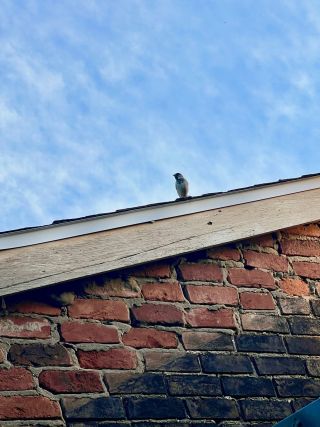
Lone sparrow
Source: By Holly Brians Ragusa
American poet and novelist Charles Bukowski said about being alone, “When nobody wakes you up in the morning, and when nobody waits for you at night. And when you can do whatever you want: What do you call it, Freedom or Loneliness?”
How can we know or appreciate the difference? How can we strike the balance? Only a personal journey into self can differentiate between the two, illuminating a mind to what level of individual freedom is craved and knowing what degree of isolation is necessary or harmful.
According to a UK study published in 2020, “Explaining Age Differences in Loneliness,” social isolation is referred to as the absence of contact with other people, whereas loneliness is described as the feeling of being lonely. To more clearly distinguish the notion, isolation means being alone and loneliness means you don’t like it.
Aloneness, then, might be the correct word to use when deliberately choosing to be in a solitary state without experiencing feelings of loneliness. In other words, not feeling isolated when making the determination to be on your lonesome, or, by yourself.
For some people, being alone is mentally distressing, and for others, solitude can feel euphoric.
Either way, our bodies respond to our choices or circumstances. Knowing what we need individually is key. Isolation impacts overall health and can lead to stress, depression, and anxiety in all demographics and early dementia, hearing loss, and even strokes in aging demographics. There are current reports that discuss loneliness as an epidemic, creating significant cultural ramifications by statistically affecting longevity and poor health outcomes.

Desolate Iceland road
Source: Holly Brians Ragusa
To appreciate our choice to be surrounded or solitary, we must recognize that sociocultural anthropology, or our social interactions, has changed drastically in the last half-century. Culturally, we are not called to attend religious institutions, family gatherings, or even our workspaces in person by even remotely the same numbers as historically known. Perceptions of proximity have changed post-pandemic. Our societal momentum is quickening, and despite longer life spans, limitations of the human form, and the necessity of physical rest and mental restoration should be taken into account.
Today, at rates unfathomable to us a century ago, we can make friends, conduct business, and learn information. The technical age of humanity is in its infancy, a mere blip in our long chronology. We are not so far removed from an age when postmasters shared news and letters carried across distances of many miles and several weeks. We need to acknowledge that speed does not equal strength in the realm of correspondence and that across social media and communication platforms, relationships are complicated in this digital age.
A 2020 Pew Research poll finds that “among partnered adults in the U.S. – that is, those who are married, cohabiting or in a committed relationship, roughly half (51 percent) say their partner is often or sometimes distracted by their cell phone while they are trying to have a conversation with them.” This can make time spent together less fulfilling, creating more feelings of loneliness.
Isolation, then, can even occur within our relationships, so for those experiencing deep loneliness, it is not appropriate and even unhealthy to seek further isolation. However, it is imperative for solitary seekers and those experiencing the stress of long hours, heavy workloads, overstimulation, and populated social or travel activity calendars to carve out time and space to be alone. From overworked educators and laborers to concerned parents and overburdened caregivers, and anyone feeling the need to reclaim quietude, creating alone time has meaningful health benefits and allows the mindset shifts that lead to authentic and purposeful living.
For all of us, when stress-filled moments arrive, feelings of resentment, anger, or withdrawal can set in. A preventative mindset knows to be on the lookout for the signals of burnout, understands seasons of hurriedness, and can sense a lack of creativity or joy in daily work or life. These indicators can lead us to designate aloneness as a priority and part of any health regimen. Scheduling regular solitary calendar events or appointments can help to achieve a step back and room to breathe into the busyness of life.
What is the art of aloneness?
“When the lips are silent, the heart has a hundred tongues,” says Rumi.

Hemlocks in coffee
Source: Holly Brians Ragusa
With unlimited access to our smartphones, binge-watching, and filling our ears with podcasts and music, are we ever truly alone? And does being alone necessitate a lack of stimulation? I think not. A night with a book or television at home alone can be satisfyingly restorative, and yet, what might a walk in the woods with only the sounds of nature heal within us? The positive effects of forest bathing or shinrin-yoku are widely proven and yet, whether at home or outdoors, it is the individual who must assess their capacity for reflective thought and feeling within the confines of sound and stimulation. Can we hear ourselves better in silence?
William Penn, an early American founder and champion of expression, said, “True silence is the rest of the mind; it is to the spirit what sleep is to the body, nourishment, and refreshment.”
When silence or solitude is not a comfortable state for an individual, there will be anxious or impatient signs, such as reaching for a smartphone, scrolling, and texting or calling a friend or family member after ending up alone or having decided to spend time alone. These signs may lead us to give up on the effort of getting to know ourselves through aloneness.

Lone tree on the Scottish hillside
Source: Holly Brians Ragusa
Remember, there are no rules to striking your own balance with solitude, and that our discomfort often leads to growth and reflection. Finding ourselves easily triggered, snappy, or irritable, are indicators that we need a break. The first step is often asking for help to take one. Whether the kids need an activity or a visit with family, or the email needs to go unanswered, offer yourself a few minutes of repose.
Meditation and mindfulness are becoming prominent, are more widely available and their benefits better understood. A plethora of online resources, videos, podcasts, and groups can assist in learning more about building a tolerance for quiet to expand a peaceful body and mind.
Try: Set a small goal for achieving five minutes of quiet in your day; this may be all you can handle or need, and yet, it can bring meaningful change.
Getting lost in the sounds of a babbling brook, doodling in a notebook on a park bench, or closing our eyes and breathing through one of life’s little storms may be the only respite we can achieve or require. A long hike or long-distance adventure in another part of the world may call you. There is no wrong or right way to view art, and therefore your aloneness is yours alone to determine. Whatever amount of time is spent in our own company will be a step on the path to knowing a more peaceful mind. The art of aloneness may simply be the daily practice of understanding what can be learned from our silence.
